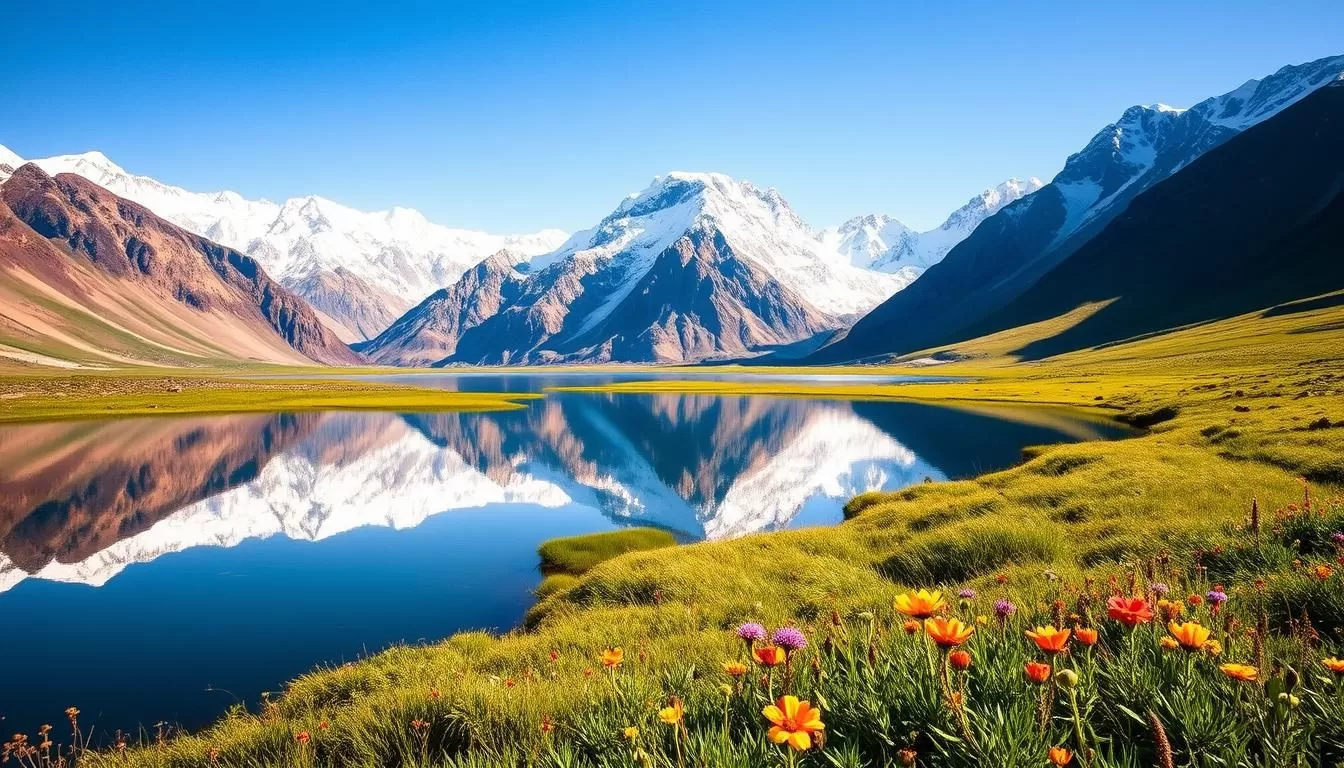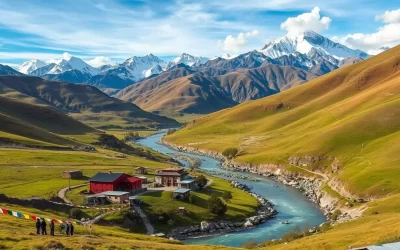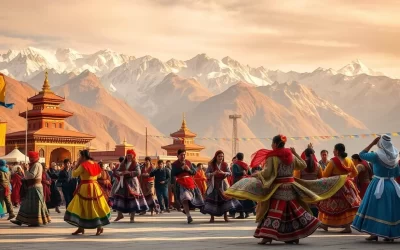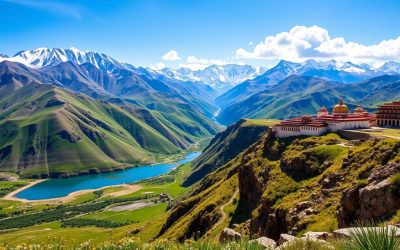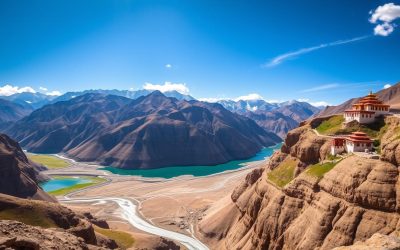Planning a trip to Ladakh can be challenging due to its extreme climate. Located in the rain shadow of the Himalayas, this high-altitude cold desert experiences dramatic temperature fluctuations throughout the year.
With 300 days of sunshine and only 100 millimeters of precipitation annually, the weather patterns in Ladakh are unique. Understanding these patterns is crucial to choosing the right time for your visit, whether you’re looking for summer warmth or winter landscapes.
You’ll discover the advantages of each season, from road accessibility and tourist density to special activities and cultural festivals, helping you plan a trip that aligns with your preferences and travel goals.
Understanding Ladakh’s Unique Climate
As you explore Ladakh, understanding its climate is crucial, given its classification as a cold desert. Ladakh’s climate is characterized by extreme temperature variations and low precipitation, making it a fascinating subject.
A High-Altitude Desert in the Himalayas
Ladakh is technically a high-altitude cold desert, receiving minimal precipitation (less than 100mm annually) despite being surrounded by the mighty Himalayas. This unique position results in around 300 days of sunshine yearly, making sun protection essential regardless of when you visit.
Two Distinct Seasons: Summer and Winter
The climate in Ladakh is divided into two main seasons: a brief four-month summer (June-September) and a long eight-month winter (October-May). Summer temperatures range from 15 to 25 degrees Celsius, while winters are extremely cold, with temperatures sometimes dropping as low as -40 degrees. This harsh climate has significantly shaped Ladakh’s dramatic landscapes and way of life.
Summer in Ladakh: June to September
If you’re looking for the best time to visit Ladakh, summer (June to September) is an ideal period, with comfortable temperatures and long sunny days. During this time, you’re treated to pleasant weather, with daytime temperatures ranging from 15-25°C (59-77°F).
Pleasant Temperatures and Peak Tourist Season
The summer season is considered the peak tourist season in Ladakh, as both major highways (Manali-Leh and Srinagar-Leh) are fully operational, making travel plans easier for you.
Summer Activities and Experiences
You can enjoy various outdoor activities, including trekking, river rafting on the Zanskar and Indus rivers, and mountain biking across spectacular landscapes. 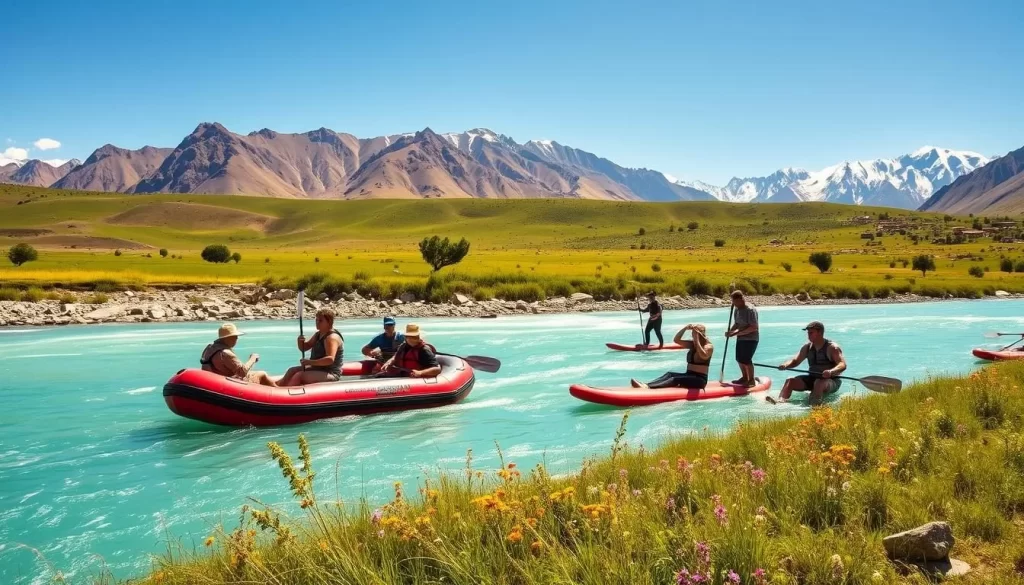
Cultural Festivals to Attend
Summer in Ladakh is also a time for vibrant cultural festivals. You can attend the Hemis Festival, featuring colorful masked dances, traditional music, and local handicrafts. The Sindhu Darshan Festival is another event worth visiting, celebrating the Sindhu River with performing arts and cultural activities.
| Festival | Month | Description |
|---|---|---|
| Hemis Festival | June/July | Colorful masked dances, traditional music, and local handicrafts |
| Sindhu Darshan Festival | June | Performing arts and cultural activities on the banks of the Sindhu River |
Winter in Ladakh: October to May
Ladakh transforms into a winter wonderland from October to May, offering a distinct travel experience. The region is characterized by harsh weather conditions, with temperatures often plummeting to -15°C (5°F) or even -40°C (-40°F) in some areas.
Navigating the Extreme Cold
To make the most of your winter visit, it’s essential to be well-prepared for the extreme cold. Ensure you pack warm clothing, including thermal layers, insulated jackets, and gloves. Proper gear will make your experience more enjoyable.
Winter Adventures
Winter in Ladakh offers unique adventure opportunities. You can embark on the famous Chadar Trek, which involves walking on the frozen Zanskar River. This experience is unlike any other in the world and is a must-try for adventure enthusiasts.
Winter Festivals and Celebrations
Ladakh celebrates various festivals during the winter season, including Losar (Ladakhi New Year), Spituk Festival, and Dosmoche. These festivals offer a glimpse into the rich cultural heritage of the region and are definitely worth attending.
| Festival | Date | Description |
|---|---|---|
| Losar | 15-day festival marking the beginning of the Ladakhi New Year | Celebrations include traditional dances, music, and rituals |
| Spituk Festival | January or February | Annual two-day gustor ritual at Spituk Monastery |
| Dosmoche | February | Two-day celebration of good over evil at Leh Palace and various monasteries |
Spring: The Blooming Season (April-May)
Spring in Ladakh is a magical time, offering a unique blend of snow-capped mountains and blooming landscapes. As the region awakens from its winter slumber, the scenery transforms dramatically.
Apricot Blossoms and Melting Lakes
During April and May, Ladakh experiences a stunning transformation. Blooming apricot trees create picturesque pink landscapes against the backdrop of still snow-capped mountains. You can witness the fascinating process of frozen lakes like Pangong Tso and Tso Moriri beginning to thaw, creating a mesmerizing patchwork of ice and turquoise water.
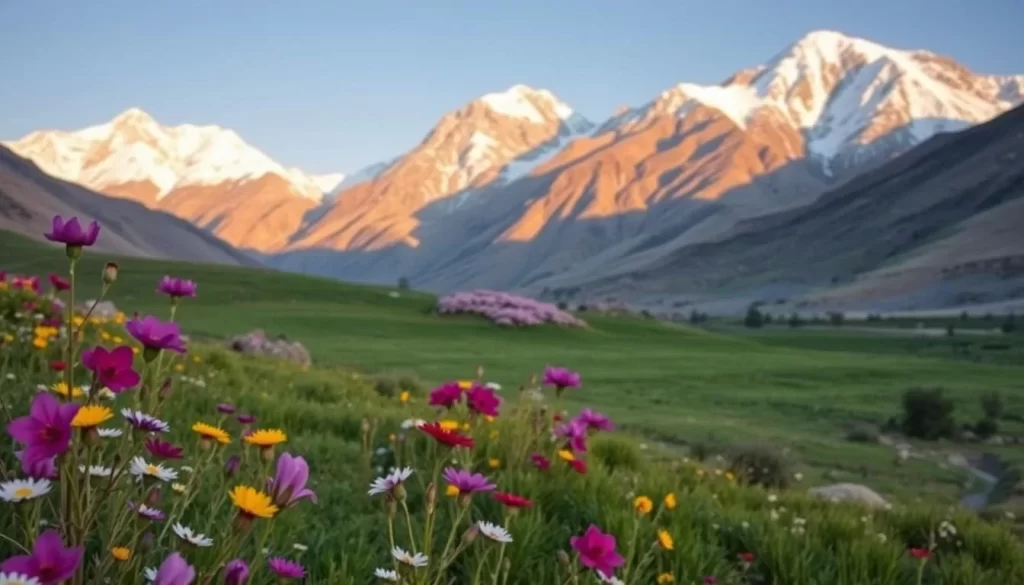
Early Tourist Season Benefits
Visiting Ladakh during the spring shoulder season means you can enjoy discounted accommodations and fewer tourists. Daytime temperatures are pleasant, ranging around 12-17°C (54-63°F), making it an ideal time to explore. Many hotels, restaurants, and tourist facilities start to reopen, preparing for the upcoming high season. You might also catch unique spring festivals, such as the Nagrang Festival at Matho Monastery.
Autumn: The Harvest Season (September-October)
September and October bring the harvest season to Ladakh, painting the region with warm hues. You can experience the best time to visit Leh Ladakh during autumn, with pleasant weather and fewer tourists.
Spectacular Fall Colors
The landscape transforms into a kaleidoscope of colors, making it a photographer’s paradise. The crystal-clear blue skies and rivers that regain their turquoise hue after the summer glacial melt provide a perfect backdrop for capturing stunning landscapes.
Fewer Crowds and Peaceful Experiences
Autumn in Ladakh offers a serene atmosphere, with significantly fewer tourists than the summer months. You can enjoy the region’s largest cultural celebration, the Ladakh Festival in September, featuring colorful processions and traditional performances. However, be aware that many accommodations and restaurants begin closing for winter by mid-October.
Road Access to Ladakh Throughout the Year
Ladakh’s accessibility by road is limited to certain months of the year, making it essential to plan your visit accordingly. The region is connected by two major highways: the Manali-Leh Highway and the Srinagar-Leh Highway.
Manali-Leh Highway: Mid-June to Early October
The Manali-Leh Highway is the most popular route to Ladakh, spanning 479 km. It passes through five high mountain passes, including Rohtang Pass and Taglang Pass, which is at an altitude of 17,480 feet above sea level. This route is open from mid-June to early October, but be cautious of altitude sickness due to the steep ascent.
Srinagar-Leh Highway: Mid-May to Mid-November
The Srinagar-Leh Highway, also known as NH1D, is a more reliable and less challenging route. It runs alongside the Indus River and passes through Zoji Pass, Drass, Kargil, and Fotu Pass. This highway is typically open from mid-May to mid-November, making it a better option for shoulder season travel.
| Highway | Distance | Operational Period |
|---|---|---|
| Manali-Leh Highway | 479 km | Mid-June to Early October |
| Srinagar-Leh Highway | 434 km | Mid-May to Mid-November |
It’s also worth noting that while road access is seasonal, you can access Ladakh year-round by air with flights to Leh, although winter flights are less frequent and more prone to weather-related cancellations.

Best Months for Specific Activities in Ladakh (UT), India
Ladakh offers a variety of activities that can be enjoyed throughout the year, but the best time for each activity varies. Planning your trip according to the season can enhance your experience.
Trekking and Outdoor Adventures
The main trekking season in Ladakh is from June to September when the weather is favorable and mountain passes are clear. Popular treks include Markha Valley, Stok Kangri, and Nubra Valley. However, if you’re looking for a unique winter experience, the Chadar Trek on the frozen Zanskar River is a thrilling adventure from mid-January to the end of February.
Photography and Sightseeing
Photography opportunities abound in Ladakh, with each season offering unique landscapes. Summer brings vibrant green valleys and clear blue lakes, while autumn is characterized by golden hues. Winter transforms the landscape into a pristine snow-covered vista, ideal for capturing breathtaking photographs.
Wildlife Spotting Opportunities
For wildlife enthusiasts, winter is the best time to spot the elusive snow leopard in Hemis National Park, from December to February. Summer, on the other hand, is ideal for spotting various bird species and other Himalayan wildlife.
- Summer (June to September) is ideal for trekking and outdoor adventures.
- Winter (mid-January to February) is the time for the Chadar Trek.
- December to February is best for snow leopard sightings.
Weather Considerations for Popular Destinations
Ladakh’s diverse landscapes and climates mean that weather conditions can vary significantly between popular destinations. Understanding these variations is key to planning a successful trip.
Pangong Lake and Nubra Valley
Your visit to Pangong Lake is best planned from June to September when the lake is fully thawed and displays its famous changing blue hues. In contrast, Nubra Valley is ideal to explore during summer months when the sand dunes contrast beautifully with snow-capped mountains.
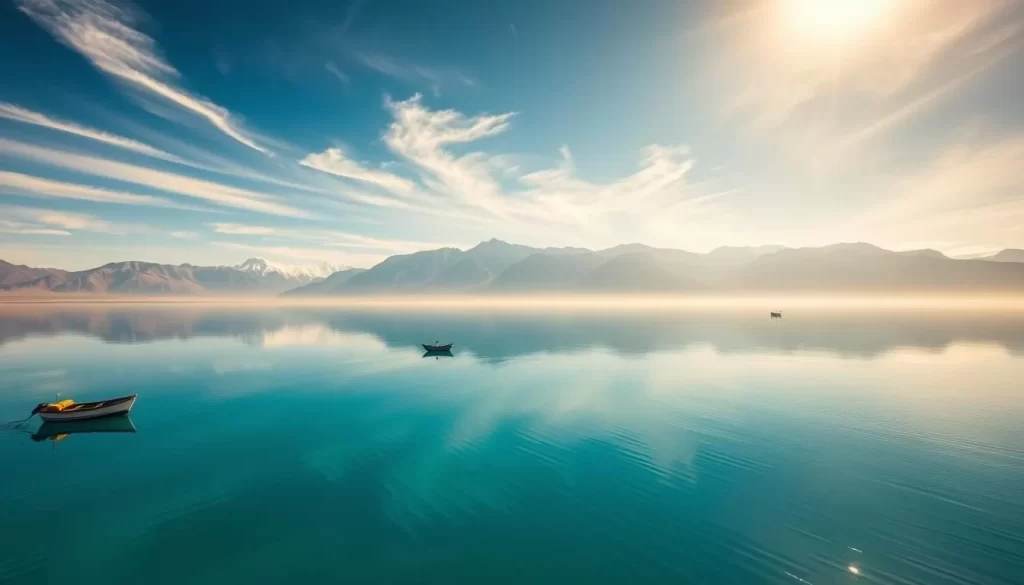
| Destination | Best Time to Visit | Weather Conditions |
|---|---|---|
| Pangong Lake | June to September | Fully thawed, changing blue hues |
| Nubra Valley | Summer months | Sand dunes with snow-capped mountains |
Tso Moriri and Zanskar Region
Tso Moriri should be visited between June and early September due to limited accommodations outside these months. The Zanskar region is virtually cut off during winter, making summer the only practical time for most visitors.
Month-by-Month Weather Breakdown
The weather in Ladakh varies greatly throughout the year, making it vital to plan accordingly. To make the most of your visit, understanding the month-by-month weather breakdown is essential.
Temperature Ranges
Temperatures in Ladakh fluctuate significantly across the months. For instance, January is the coldest month with daytime averages of -3°C (27°F) and nighttime temperatures dropping to -15°C (5°F) or lower. In contrast, July is the warmest month, averaging 25°C (77°F) during the day and 10°C (50°F) at night.
Precipitation Patterns
Ladakh is a high-altitude desert, receiving minimal precipitation throughout the year. Even during the “wettest” months (July-August), the region receives only about 15mm (0.6in) of precipitation and experiences around 2 rainy days per month. The monsoon has a negligible impact on Ladakh, making it an ideal destination for those seeking to avoid heavy rain.
Daylight Hours
The daylight hours in Ladakh vary significantly throughout the year. In June, you can expect nearly 14.5 hours of daylight, with sunrise at 5:07 AM and sunset at 7:32 PM. Conversely, December has less than 10 hours of daylight, with sunrise at 7:18 AM and sunset at 5:11 PM.
Conclusion: Choosing Your Perfect Time to Visit Ladakh
Ladakh’s unique landscapes and experiences are accessible throughout the year, but the best time to visit depends on your priorities. You can choose to visit during summer (June-September) for easier access and milder temperatures, or opt for the shoulder seasons (April-May or September-October) for a balance between good weather and fewer tourists. If you’re prepared for extreme conditions, winter (November-March) offers unique landscapes and activities like the Chadar Trek. Ultimately, your decision will depend on what you value most in your travel experience.
